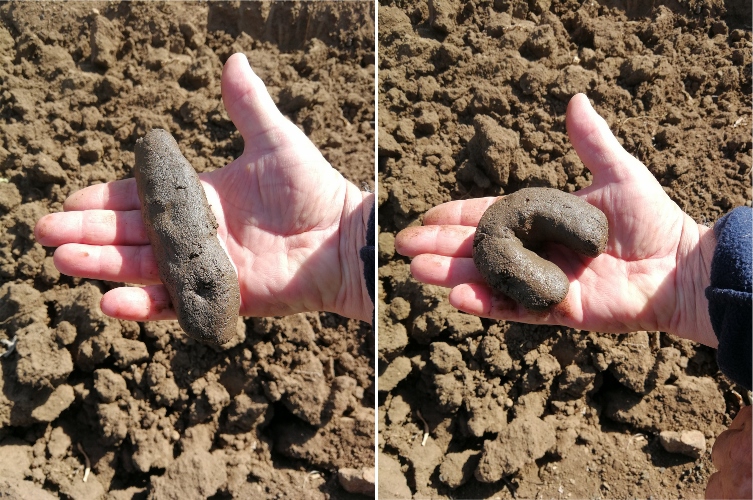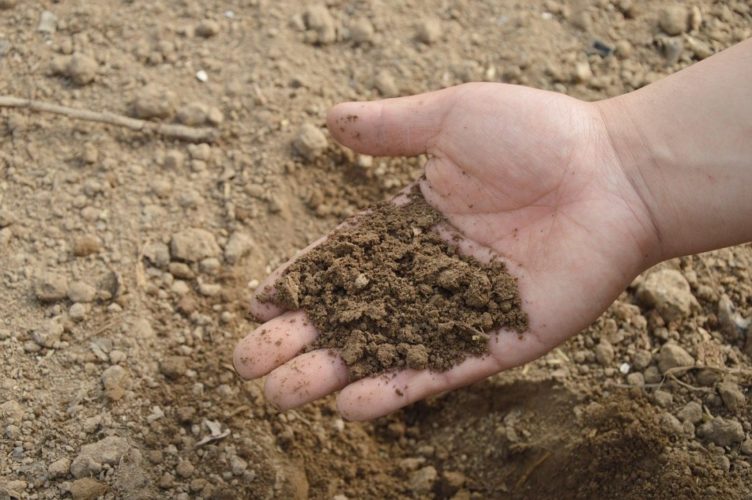If you can find out your soil’s texture, composition, drainage, acidity and mineral density, you will avoid the disappointing results that can occur when your soil is unsuitable for what you are trying to grow. Luckily, there are some tests you can do on your soil at home.
Knowing the structure of your soil will help you determine how much water and organic matter you will need to apply.
Your soil is a mass of mineral particles, water, air and dead organic matter. The size and form of those particles make up the basic soil structure.
Soil Structure
Soil is made up of three components: clay, sand and silt.
Clay is the smallest mineral component. These tiny flat particles fit closely together to create the greatest surface area of all soil types. Clay soil contains needed nutrients and also stores water well. So well in fact, that drainage is slow in clay soil. It is also the slowest to warm in the spring.
Sand makes up the largest particles in soil structure. These are rounded, rather than flat and allows for larger space between the particles. Water drains quickly from the soil that has a lot of sand and the nutrients drain faster too. If your soil is mostly sand the plants will need more water and fertilizer.
Silt represents the middle size pieces. It is made up of rock and mineral particles that are larger than clay but smaller than sand. Individual silt particles are so small that they are difficult to see. To be classified as silt, a particle must be less than .005cm across.
The combination of these three particles in the right balance is called loam and is considered the ideal garden soil. Knowing how close (or far) you are from loam will help you decided what amendments to make to your soil.
Testing Your Soil
There are different simple DIY tests that you can do. There is the bottle test.

Take a bottle and fill a third of it with the soil you want to test. Pour water into the bottle until it is almost full. Put a lid on and shake it well for a few minutes. Leave the bottle for an hour so that the soil can settle in the water.
The substances will settle in layers. Each layer will have a different colour and consistency. Heavy particles (gravel, pebbles and sand) will fall quickly to the bottom of the bottle. Finer substances will accumulate on top of the heavy particles (silt, humus, and then the fine and very fine clay). The top layer of the water will stay cloudy for a long time, because it will contain clay particles which are so small that they stay floating in the water. Substances which are lighter than water (leaves, seeds, spores, insect and animal waste) will float on top.
Another test you can carry out entails taking a handful of soil and feeling it. Is it rough, smooth or sticky? Then, wet the soil in your hand and try to make a sausage. The results should give you a broad idea of the type of soil that you have.

Clay soil: Water does not pass easily into clay and plant roots do not grow easily. Clay soil feels smooth and sticky and when you make your sausage with wet clay soil, you will be able to bend your sausage into a ring.
Sandy soil: Water passes quickly into sandy soil, roots grow easily but the soil becomes dry quickly. Very sandy soil will feel very rough and you will not be able to roll it into a sausage. Sandy soil with a little loam in it can be made into a sausage but it will crumble easily if you try to bend it.
Loam soil contains sand and silt. Roots grow easily in it and it holds water and nutrients. Loam feels a little rough and sandy, quite smooth but not sticky. It can be made into a sausage, which you should be able to bend half way round.
The majority of vegetables, herbs and fruit trees flourish in loam.
Another useful soil test to carry out is to find out whether your soil is acid or alkaline. The pH or acidity level of your soil has a large part to do with how well your plants grow and pH is tested on a scale of one to fourteen, with one being very acidic and fourteen being very alkaline. Knowing your soil pH is the key to understanding if essential minerals will be available to the roots of your plants.
You can test your garden soil pH with vinegar and bicarbonate of soda.
Collect 1 cup of soil from different parts of your garden and put two spoons-full into two separate containers. Add 1/2 cup of vinegar to the soil in one. If it fizzes, you have alkaline soil, with a pH between 7 and 8. The chemical reaction that you’re seeing occurs when an acid (the vinegar) comes into contact with something alkaline (the soil).
If it doesn’t fizz after doing the vinegar test, then add half a cup of water to the other container and mix. Add 1/2 cup bicarb. If it fizzes you have acidic soil, most likely with a pH between 5 and 6. The reaction you’re seeing is the result of acidic soil coming into contact with an alkaline substance (the bicarbonate of soda).
If your soil doesn’t react at all it is neutral with a pH of 7 and you are very lucky.
You can add different substances to the soil to alter the pH. Soil amendment takes time however, so make small changes and wait for them to take hold before making further amendments.
You may have different types of soil in different parts of your smallholding, so consider testing each of your beds.
There are soil testing kits available from some nurseries and hardware stores. Some enable one to test the NPK of the soil, while others have probes which measure the pH and moisture content. They vary considerably in accuracy and sophistication and therefore in price.
This is part two in a five-part series on Soil Health. For more, click here.


Dear Madam / Sir. Thank you for this very useful magazine to the Smallholder. A lot of information especially the home soil testing tips and soil preparation are key sources of knowledge. Please help with how to add contours to my garden?